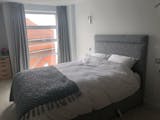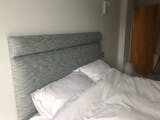Wooden furniture is renowned for its hard-wearing nature and its versatility of style. There's so much variation to be found in wood – different colours, textures, finishes, grains and stains – which allows for an interior design that incorporates a whole range of woods.
It can be intimidating to try and fit a mixture of wood furniture into your bedroom if you don’t feel like you have much interior design knowledge or experience but, once you get started, you will be reaping the benefits in no time.
So, with that in mind, here is our quick-start guide on how to mix and match wood furniture in the bedroom.
How to mix and match wood furniture in the bedroom
Choose a striking centrepiece
When you are looking at how to mix and match wood furniture in the bedroom, the first thing that you may wish to consider is choosing the centrepiece.
The centrepiece is usually one of the largest pieces of furniture in the room, as it takes up a lot of space and draws the eye much more. In a bedroom, often the piece of furniture chosen to build the rest of the interior design around is, unsurprisingly, the bed.
Deciding which type and style of wood you want this main piece of furniture to be made out of is important, as it can strongly inform the rest of the design of the room. For example, dark woods look solid and elegant, whereas light woods look bright, clean and give a sense of more space to a room.
Another consideration here is the flooring. Do you want wooden floorboards as well, or are you looking for carpets? If it’s the former, then you need to pay attention to the smaller details such as the grain, colour temperature and finish of the wood, to make sure that your new centrepiece doesn’t clash with your flooring in an unwanted way. More on these considerations below.
As well as the bed, the secondary piece of furniture tends to be a wardrobe, which can be quite large and take up a lot of vertical visual space.
You could, if you preferred, use a wardrobe as the piece of wooden furniture to build the rest of your design around, but the reason why many people choose the bed is because of its more prominent position in most bedrooms. Wardrobes tend to be pushed to the sides of a wall, as unobtrusive as possible, which makes it the second choice to the bed when choosing an anchor for your interior design.
Once you have chosen your centrepiece, it should be easier to now choose the rest of your wooden furniture, without risking having to compromise on your dream wooden bed.

Product: Salerno Oak Bedroom Collection
Create continuous themes
Hopefully, once you have your centrepiece in mind, and know what the wood will look like, you can start expanding outwards into the rest of the room. The idea of creating and following consistent themes through the design is illustrated by the phrase ‘tying the room together’.
The first thing you want to consider when mixing and matching different woods and wood styles is the colour temperature. This basic bit of colour theory can really help to make sure a space looks like it was all designed by the same person for the same purpose – there are ‘cool’ colours, like blues, pinks and purples, and ‘warm’ colours like reds and oranges.
These colours are known as your undertones, and by matching the colour temperature you can get away with a lot more variation in the types of wood you use for your furniture. You don’t have to pay particular attention to exactly matching the colours of your wooden furniture, as long as the colours all stay within the same colour temperature spectrum. Bear in mind that this is a general rule and not the law. If you want contrast, have contrast! Just be aware that more consideration might have to be made in the planning process.
Another thing to consider is the physical properties of the wood. For example the grain patterns can have an impact as to how things are laid out, because lots of grains crossing each other at parallel line can quickly become visually messy, and leave your room not looking quite as good as it could.
Soften with textiles
By now you hopefully have a better idea of how to start mixing wood styles with positive results. Now comes the part which really finishes a room off...the accessorising.
If you have chosen large, solid wooden furniture for those main pieces we mentioned – your bed, wardrobe, dressers and any other larger bedroom furniture - then it is a good idea to begin to soften some of those straight lines and hard corners with something a bit more cosy and comfortable.
Again, the main soft furnishing would usually be a mattress, and this is somewhere where you want to buy high-quality that is going to last a long time, and ideally one that is made-to-measure, to ensure that your bespoke mattress fits your bed, as well as you.
If you have floorboards in your bedroom, a great way to break up a large wooden floor space is with the uses of rugs. Especially in larger rooms, placing the bed and other furniture on top of rugs can really tie disparate styles together. No matter what flooring you have, it will be much easier to tie in different woods into your room, with the added benefits of protecting your floor from stains, dints and scratches.
Soft furnishings like upholstered dressing table stools are a great choice to add a few more rounded edges to a room full of straight wood grain and parallel lines. Or, if your bedroom has a little more room around which to lounge, you may even find space for a bespoke sofa, just to add some extra warmth and comfort to your room.
Other soft furnishings like curtains, bed linen, cushions and pillows can all be chosen with your design in mind. By picking textures, colours or colour temperatures as we mentioned earlier that all go together, you can use these soft furnishings strategically to marry the different wooden furniture together for a stunning final effect.
Consult the experts
If you wish to find out more information about how to mix and match wood furniture in the bedroom, wish to order one of our bespoke wooden beds, made-to-measure mattresses or other furniture, contact us using the form on our website, by emailing sales@endurancebeds.co.uk, or by calling 01553 401844







